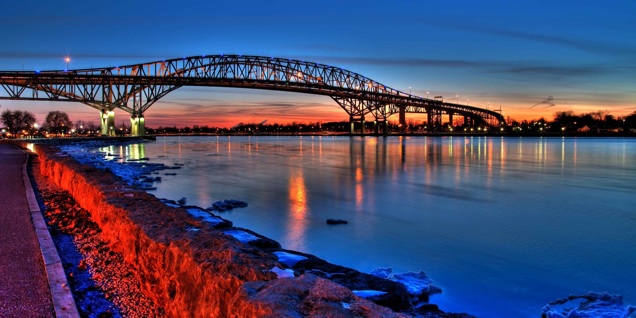The Bluewater Bridges

The first bridge was opened to traffic on October 10, 1938. The lead engineer was Ralph Modjeski. This bridge originally had two lanes for vehicles as well as sidewalks; the latter were removed in the 1980s to make room for a third lane for automobiles. The third lane for each direction started from the apex of the bridge in order to accommodate long lineups entering each sides' respective border crossings.
Traffic volumes steadily increased, spurred by the completion of Highway 402 in 1982 which provided a continuous freeway link to 401. As a precursor to the upcoming twinning project, the customs and toll collection booths on both sides were extensively reconfigured in the early 1990s. In the US, the I-beam girder overpass was replaced by a much wider embankment, which also added a four-story customs office building in the center. On the Canadian side this necessitated the demolition of the original booths that had been in use since 1938, these booths were noted for their Art Deco style but they were too low to accommodate semi-trailer trucks which had been directed to the outside.
In the early 1990s, bridge authorities decided to add a second arch in order to accommodate the high traffic. During the debate over the form of the second span, five possible designs were purposed from 1994-95. Over half of public opinion had mostly favored a duplicate of the first bridge, while the cable-stayed bridge came in second with around 21%. The Blue Water Bridge Authority had rejected both designs, due to the duplicate creating a false sense of history, while the cable-stayed option was feared to overshadow the existing bridge. Another cost-effective but unpopular design was the parallel truss. The continuous-tied arch design, which was a distant third place in polls, was chosen for two reasons. One was that it blends in with the original span yet stands out on its own, and the other is lower maintenance costs because fewer spans are involved.
US engineers learned metric before the project commenced. The twinning project was a combined effort between Modjeski & Masters — U.S Engineers and Buckland & Taylor Ltd. - Canadian Engineers. During the construction, two temporary masts were erected to assist in the construction of the tied arch; the towers were painted red and lighted, enabling them to be seen from afar. The approaches to the new bridge use box girders, compared to the original which hold up the road deck with trusses.
The second three-lane bridge, just south of the first bridge, opened on July 22, 1997. The first bridge was immediately closed afterward for extensive renovation and reopened in 1999. The newer bridge used a similar 3-lane configuration for a couple years. A flyover ramp on the US side temporarily diverted westbound traffic from the new bridge to the toll plaza, which was blocked off after the original bridge was rehabilitated.toll plaza, which was blocked off after the original bridge was rehabilitated.
History of the Bridges from Wikipedia
